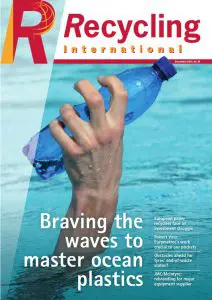Page 8 from: December 2014

8 December 2014
N E W S
The review, based on a survey of 250
companies, 15 industry associations
and 25 national authorities, looked
into EoW impacts on scrap availability,
trade flows, prices, administrative
requirements and the environment/
human health. It reveals that more
than 40% of participants felt that the
quality on the market had improved for
all scrap and particularly for EoW-
compliant scrap, mainly due to ‘the
strict rules on maximum contamination
and the wider introduction of quality
management systems’.
High uptake in Italy
Uptake has been most pronounced in
Italy where more than 1000 scrap com-
panies generate EoW-compliant scrap,
although this is partly due to a similar
legal framework on secondary raw
materials that preceded the introduction
of the new Europe-wide EoW criteria.
In the rest of Europe, uptake has been
restricted to around 100 scrap compa-
nies active in EoW scrap markets,
although significant industry interest
has been recorded in the UK, the Neth-
erlands and Spain in particular. One
explanation offered for the relatively
low number is the length of time it can
take to certify a quality management
system (QMS) and adopt the criteria,
with the report mentioning ‘at least
two years when starting from scratch’.
Coming into force in 2011, it was EU
Regulation 333 that established crite-
ria by which scrap from iron and steel,
aluminium and aluminium alloys could
cease to be regulated as waste. The
JRC study estimates that at least 15%
of EU scrap steel consumption and
10% of scrap aluminium is EoW-com-
pliant, with the majority consumed in
Italian furnaces. However, some sig-
nificant quantities of compliant scrap
appear to be generated in countries
other than Italy which are then export-
ed for consumption in Italy.
Benefits identified
‘Importantly,’ says the report, ‘neither
the results from the surveys nor the
feedback from an expert workshop
have indicated that end-of-waste had,
so far, caused any negative impacts on
the market, whether that is to scrap
quality, availability/trade, or upon the
environment. On the contrary, quite a
number of the survey participants have
highlighted the benefits of the intro-
duction of end-of-waste for metal
scrap.’
The identified benefits included: a sim-
plified regulatory framework with rela-
tion to the reduction of the impacts of
waste legislation, such as no longer
needing to obtain waste permits and
licences; greater flexibility and legal
certainty for companies, allowing a
clear choice between operating under
waste legislation or under the EoW
framework; and improving the quality
of scrap, leading to a perceived
increase in the prices for scrap of
approximately 1% and hence poten-
tially to ‘enhanced sales revenues for
scrap companies’.
However, some companies reported that
the costs of achieving EoW compliance
had outweighed the benefits. For exam-
ple, some said the costs associated with
new QMS certification or with improving
the technical recycling process to reduce
contamination levels were higher than
their expected benefits.
A repeat of the surveys in two to three
years from now has been deemed
appropriate as, by then, EoW criteria
will have had further time to be imple-
mented for iron, steel and aluminium.
Furthermore, copper scrap could then
be added to the scope of the exercise,
the JRC study points out.
‘Very good’ and ‘important’
The BIR world recycling organisation
has been a major driving force behind
EoW and its environmental & technical
director Ross Bartley has welcomed the
JRC report as both ‘very good’ and
‘important’.
The initial, widely-supported idea
behind EoW had been to improve eco-
nomic efficiency by relieving scrap from
costly waste regulation, with the ‘trade-
off’ being the introduction of quality
management systems and removal of
waste-like properties from scrap
through processing to a very high qual-
ity, he explains. Although metal works
and others expressed fears that the
result would be an exodus of scrap as
a product from the EU, ‘this report
shows through government statistics
that end-of-waste has not increased EU
exports’. Furthermore, the costs associ-
ated with obtaining QMS certification
should be viewed in the context of the
wider company benefits delivered by
this process, Bartley insists. ‘It’s time
again for a wide industry support for
end-of-waste,’ he declares.
End-of-waste contribution has
been nothing but positive
EU end-of-waste (EoW) rules governing scrap from iron and
steel, aluminium and aluminium alloys have had no negative
effects either on the market or on the environment, according
to a major study by the European Commission’s Joint Research
Centre (JRC). In fact, it adds, a number of tangible benefits have
accrued from EoW.
By Ian Martin
Ross Bartley: ‘Time again for a wide industry support
for end-of-waste.’
10% of scrap aluminium is EoW-compliant.
RI-10 NEWS.indd 8 04-12-14 14:40



